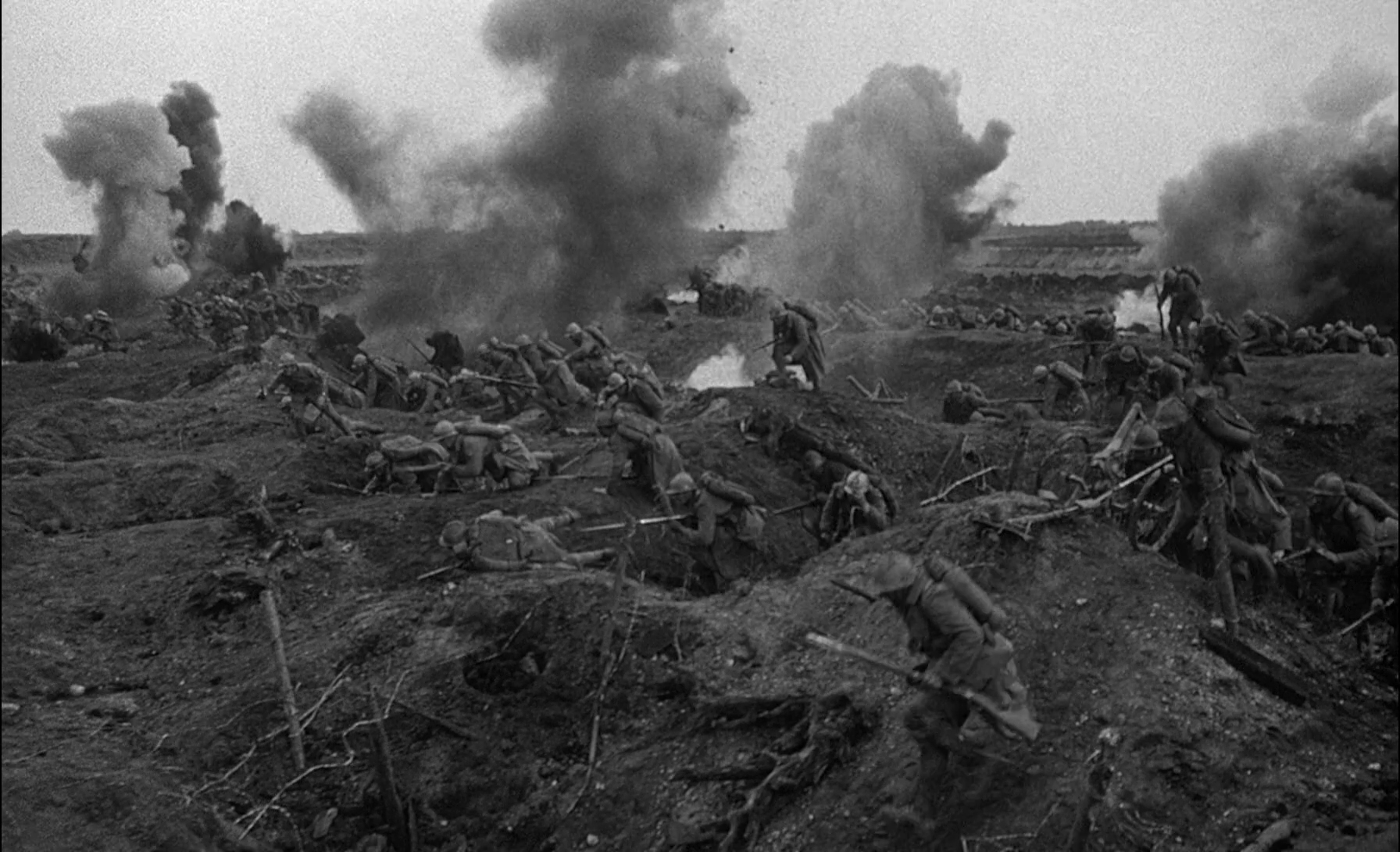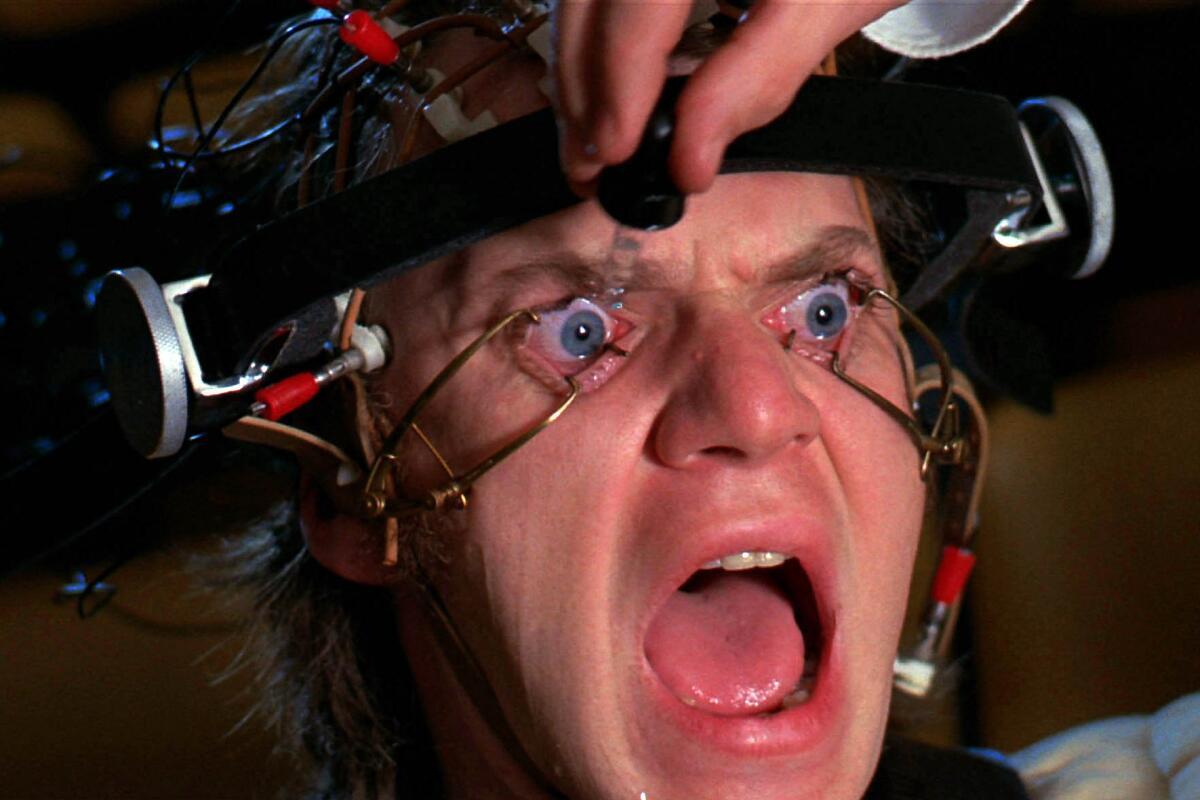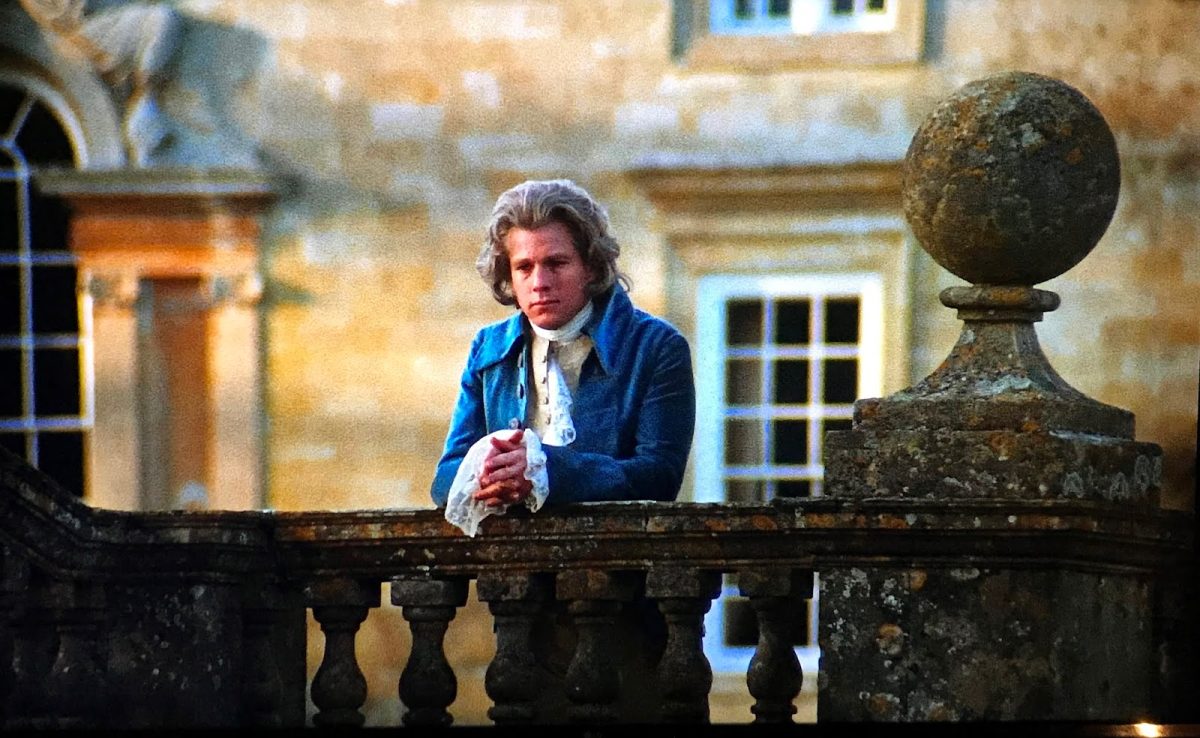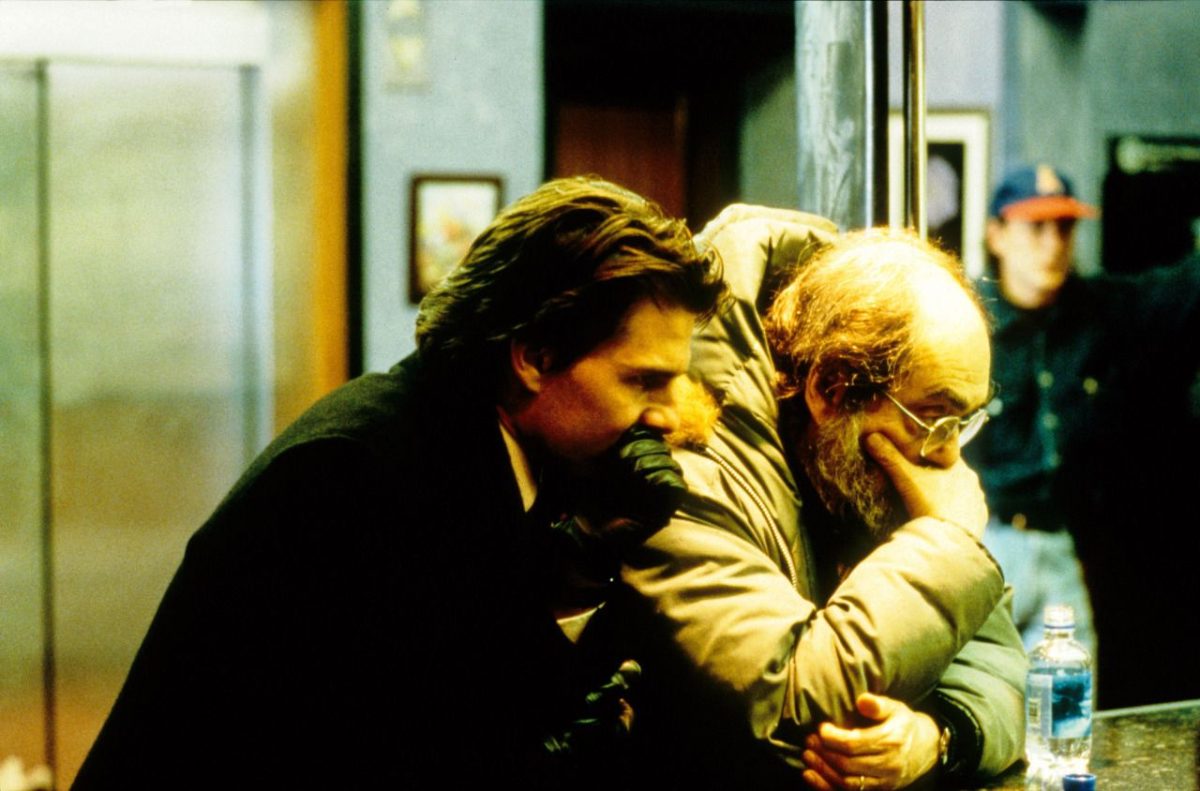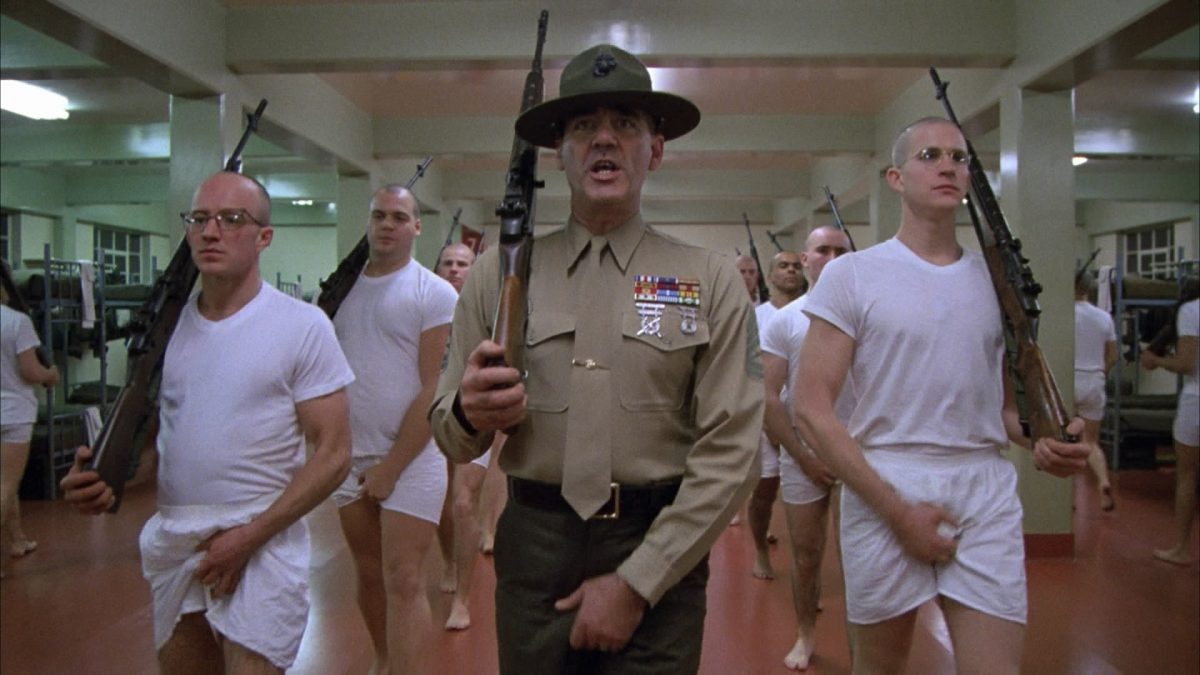Of Stanley Kubrick‘s seven feature-length films, three, including two of the best, have been explicitly concerned with militarism and war. The most recent of these, Dr. Strangelove, has made Kubrick the darling of the Ban-the-Bomb movements, being widely taken as a satirical demolition of those who have “stopped worrying and learned to love the bomb.” Yet Dr. Strangelove is a curiously and disturbingly ambiguous film. Edward Teller and General Curt LeMay are not its only targets, and if satire is aimed, as Swift insisted, at improvement, then this picture seems to urge the improvement of the earth by the extermination of mankind. It suggests that we are, indeed, going to blow ourselves up but it isn’t very sad or shameful, or even very important.
Furthermore, Paths of Glory, which seems to me Kubrick’s best film so far, does not so much attack militarism as take war as a fair specimen of human behavior—rather as The Killing calmly views a band of holdup men as typical professionals, trying to do their work despite the little human failings that plague us all.
Kubrick films are very bloody and cruel. For savage assault upon the viewer’s nerves and hopes, there is little in modern film to match the protracted death-march in Paths of Glory, and the Kubrick canon includes also Lolita, with its murder shown lovingly and lengthily not once but twice; the explosive massacre in The Killing; the Spartacus blood-bath; and the unforgettable “thump” of the dying general’s nose hitting the floor in fear and desire. This virtually sadistic treatment of the audience must be accounted for, along with the numerous ambiguities of Strangelove, if Kubrick’s particular brand of anti-militarism, and its effect on his work, is to be understood. One must account, above all, for the generally gloomy tone of his work. Killer’s Kiss, which is alone among his pictures in having a conventionally cheerful ending, was the one film over which Kubrick’s control was severely limited.
I wish to examine the three “anti-war” pictures closely, with reference where it is helpful to the other films.
Chronologically, the three pictures are a skeleton of Kubrick’s career: Strangelove is the most recent, Paths of Glory (1957) stands roughly in the middle, and Fear and Desire (1953) was his first full-length fiction film. Fear and Desire is a painfully amateurish picture. The script by Howard O. Sackler is embarrassingly banal—a virtually incomprehensible story tricked out with vague, adolescent pessimism masquerading as Deep Thought. The post-recorded sound is terrible: the sound level doesn’t vary throughout, a character sounding exactly the same in an interior close-up as he does in an exterior medium-long shot, and all of them sounding muffled and at the same time elocutionary. The actors are inexperienced (although the screenplay might have challenged the most seasoned players) and production details have a painfully homemade quality not far above the mise en scène of a junior high school play.
The film is about four soldiers behind enemy lines during an unidentified war: two privates —one a callow boy and one a middle-aged family man—a tough sergeant, and the pilot of the transport whose crash they survived. The pilot is a college intellectual seeking “Meaning.”
Under his leadership they make their way warily through the woods and at nightfall they attack and slaughter a small detachment of enemy soldiers whom they surprise peacefully eating supper in a shack. The next day they encounter a group of women. They hide, but one of them sees the men and they take her prisoner. She is tied to a tree, the youngest soldier is left to watch over her, and the rest proceed to the river where they hope to construct a raft that will bear them downstream to their own lines. In their absence the young soldier, demoralized by the earlier massacre, attempts to befriend the uncomprehending girl, then to convince her of his innocence. Frustrated by her terror and incomprehension, he releases her, then runs gibbering to the river, completely demented. The others have discovered, while building the raft, an enemy command post in a farm-house. There is a general at the post, and a light plane, and after some confusing debate about courses of safety, duty, or ambition, they evolve a plan to kill the general and escape with the plane. Their plan requires the sergeant to make a daring diversionary attack, which he sees as his chance for glory. The general is killed by the lieutenant, who then escapes in the plane with the second private. In safety, they await the sergeant, who arrives by raft with the first private, whom he has found babbling in the shallows. The lieutenant finds that it has all been meaningless; the private’s madness, the sergeant’s heroism, and his own murder of the general, have left them just where they started.
Cinematically, Fear and Desire shows some of the rag-bag quality one expects from a novice director who has studied his art: a couple of Rashomon shots, a Renoir shot. But on the whole it is surprisingly personal and original. Despite its several particular badnesses and its general fuzziness, the film has a striking purity and honesty and is unmistakably the product of a single man’s striving. Its processes are governed by decisions of thought and feeling rather than by formulae or the counsels of caution. Its distribution was limited, as is inevitable for a film made outside the normal commercial structure, but it attained a degree of fame, assisted by a respectful notice in the New York Times (“It augurs well for the comparative tyros who made it”) and a patronizing and imperceptive Time review.
Fear and Desire was an honorable failure in a realm where failures often are even more reekingly corrupt than successes. Few directors who come up through the Hollywood mill (or any other film mill, for that matter) are ever allowed the chances to learn from honorable failure that are taken for granted in other arts, simply because of the money involved. A novelist’s two or three floundering first efforts cost him four or five years and twenty dollars worth of paper, a novice painter spoils canvas after canvas with borrowed or stolen pigments, but a film director’s baby steps cost a thousand dollars a minute—which means, in fact, that he isn’t permitted any baby steps. Kubrick is unique among current American directors in having served a meaningful apprenticeship.
There is more to Fear and Desire, however, than mere rarity; a powerful and complex emotion is conveyed, and a vision of the vexing conflicts of virtue and authority and the uncertainty which swathes every moral choice. It is a vision of clarity (despite the vapidity of the lines assigned the lieutenant) and depth and dignity, and it is conveyed by means of image. This vision, in fact, is more effectively and simply stated by one central shot from the film than by any possible paraphrase or declaration, and that is in the scene of the shooting of the general, who is the type of authority and age, by the lieutenant, the type of youth, rebellion and moral yearning. The wounded general drags himself on his belly to the door of the farmhouse—a slow, painful, suspenseful progress. He crawls out onto the porch, to the edge of the circle of light falling from within, and raises his head to confront his attackers. The lieutenant, standing in the darkness, raises his pistol, and the eyes of the two men meet. There is another agonizing hesitation, then the lieutenant fires and the general’s head falls forward, his face striking the boards with a sickening thud. The confrontation of youth and age, rebellion and authority, moral striving and moral complacency, is given its particular point, however, by Kubrick’s double-casting of the roles. The same actor, Kenneth Harp, plays both the lieutenant and the general. This is a rather painfully obvious way of suggesting the ambiguity of the types and the difficulty of decision, but at least it doesn’t sentimentalize the point and it does, most importantly, render it visually. And this notion of a disturbing identity of the moral types, or an even more disturbing instability of the types, is the vision to be vividly realized three films later in Paths of Glory, and is the source of the despairing whoops of Dr. Strangelove.
It would be a mistake to derive a final evaluation of any director’s career from consideration of one film—especially a bad early film which the director has all but disowned (as Kubrick has disowned Fear and Desire, mention of which seems to depress him). Nor do I wish to rest this discussion upon the fragile base of my reading of the single fact of Kubrick’s double-casting of the lieutenant and the general. Nonetheless, the very badness of the film, its baldness, makes its basic images particularly accessible, and when those same images are re-created in later Kubrick films the vision of moral dubiety as man’s tragic burden becomes more and more central to the director’s work. I would note that never, from the beginning in Fear and Desire right through Strangelove, is Kubrick himself a victim of the ambiguity he portrays, nor does he practice that commonplace false irony which consists in giving a judgment with the right hand and taking it away with the left.
Fear and Desire was followed by Killer’s Kiss, Kubrick’s least interesting and least personal film— “least personal” in that it seems to have little of the characteristic flavor of his work, even though he did write, photograph, and edit the picture himself. It was his first effort for a major studio—United Artists—and on the evidence of the film itself Kubrick must have been under considerable constraint.
It was with his next, The Killing, that Kubrick achieved widespread attention and appreciation. Again the screenplay was Kubrick’s own, and this time with a much greater stamp of originality. In form, Kubrick experimented with narration by means of overlapping story segments—the off-screen narrator keeps things straight while the picture backs up to view a piece of action for the second, third, or fourth time. Each “re-run” brings the story up to the point of the beginning of the horse-race during which a gang of holdup men intend to rob the cash-room of a race-track, and the track announcer’s voice, grating from the loudspeakers, backgrounds various events to establish their simultaneity as Kubrick puts together his puzzle-plot, so that by the last time we view the fight at the bar we are reminded by the announcer of all the other things that are going on at this very moment. The substance of the film is a fairly conventional gangster story of the Rififi tradition: emphasizing the professional details of burglary and the everyday humanity of the crooks, with no moralizing. In keeping with the tradition, the crooks are undone (as required by the Production Code) not because they are wicked but because they are human—in The Killing it is a uxorious husband who spoils things.
Paths of Glory (1957) opens, as does The Killing, with an off-screen narrator’s voice, but the narrator does not reappear and the structure of Paths of Glory is a brilliant advance over that of the earlier picture, achieving rhythm without repetition through recurrent images of men walking—suggested, perhaps, by the “paths” of the title. A company of soldiers marches past the camera at the opening of the film, their boots crunching in the gravel yard of the chateau with a sound which will come back before the film ends. Within the chateau the heels of the staff officers and orderlies ring crisply and hollowly, foreshadowing the “paths” of the doomed men at their trial. In one of the most brilliant sequences of the film, Colonel Dax (Kirk Douglas) takes a long, nightmarish walk down the trench where his men await the signal to attack, while the smoke thickens and the roar of the barrage builds up. The attack itself is a grotesque, shambling, crouching, stumbling walk to death. The men march disconsolately into the chateau grounds. The court martial is staged as a series of precise, geometrical drill-field maneuvers, with the heels on the hollow tile again ringing loud; and finally comes the interminable and nerve-shattering march to the execution, with the footsteps of the condemned men crunching away their last seconds of life.
None of these walks gets anybody anywhere: all the paths end in death or frustration, or simply getting back where you started from. At the end of the film, Colonel Dax calls for a respite— “Give the men a few more minutes, Sergeant,”—when he is reminded that they must be marching back to the front, but it is only a respite, and soon they’ll all set off again on the treadmill walk to oblivion.
Against the futility of the Paths of Glory (or ambition, or justice, or duty) the film offers faint hope. After the execution, Dax is disgusted to find his men in a tavern tormenting a captive German girl who is being forced to sing for them, but their catcalls and whistles turn to tears as the weeping girl tremulously sings her song of a soldier’s sweetheart. They understand that the song is about them, and briefly they feel at one with her, her sweetheart, and all doomed soldiers everywhere. This vision of the possibility of compassion is consoling, but scarcely redeeming, particularly in view of the following assurance that they will go back into the trenches, led by the good Colonel Dax.
One of the most powerful scenes in this powerful film—the famous “cockroach line”—casts a perplexingly ambiguous fight upon the whole action. In the stable-prison the night before the execution, Corporal Paris cries, “Tomorrow, when Tm dead, that cockroach will be closer to my wife than I’ll be,” and Private Ferolles smashes the cockroach with his fist saying: “Now you’re one up on the cockroach.” By a brutal act of destruction, an illusion of power is achieved. Later on, the fives of the three soldiers are snuffed out as abruptly and brutally as was the cockroach’s fife, for the sake of General Mireau’s illusion of power. Mireau himself is professionally destroyed by General Broulard for the sake of his power which, presumably, is another illusion. By extension, the war itself is a similar act of destruction in support of a similar human illusion and, perversely, we begin to see war as springing from the love of life—the love of one’s own fife. The love of life cannot be condemned, but here it is easily converted into envy or fear of the lives of others, and expressed as brutality, coldness, or cowardice.
This is nothing as comfortable and obvious as “anti-war.” Warfare may be the worst possible expression of the love of life and compassion the best, but both spring, puzzlingly, from the same source and one is as likely as the other. Neither signifies much for long. Lear cried: “As flies to wanton boys are we to the gods!” while Kubrick seems to say: “As the cockroach to Ferolles, as Ferolles to Mireau, as Mireau to Broulard, are we to the gods!” In such a context, Colonel Dax’s demands for justice become just another path to the grave. He rages at the cynical and corrupt General Broulard (who is untouched by his contempt), and the monstrous Mireau is crushed, but die three innocent men are already dead and the troops are going back to war. The only feasible attitude seems to be the stoicism of the sergeant in command of the firing-squad, who counsels the condemned corporal to “die like a man. We’ll all be joining you soon.”
After Paths of Glory came Kubrick’s widescreen, cast-of-thousands, pseudo-historical spectacle, Spartacus. Although not a war-movie, it came with the best liberal credentials —screenplay by Dalton Trumbo from a Howard Fast novel. Spartacus had its moments (several thousand extras in Roman armor are exciting, no matter what kind of blah is sloshing around them) but was a rather ordinary specimen of its kind, i.e., an orgy of mutilation and brutality-lashings, gladiatorial combats, bleeding stumps of limbs, mounds of dead, crucifixions —followed by a church-of-your-choice inspirational message: “Spartacus, your son is free!” About all Kubrick added to the brew was homosexuality (powerful and touching in The Killing, but just plain excruciating in Spartacus) and a certain gritty believability of detail. In one scene, however, he did touch again upon the ambiguity of love and aggression. Spartacus and his friend David are forced by then- captors to fight, the loser to die quickly by the sword, the winner to be crucified; each battles savagely to save the other from the cross. Spartacus finally disarms David, pins him in a grip like a lovers, looks into his face, says, “I love you, David,” and stabs him in the heart. Here the moral and emotional ambiguity of the act is reinforced by a sexual ambiguity.
Lolita (1962) had a somewhat similar use of sexual irregularity at its very base. Humbert Humbert is the lover whose embrace is unnatural and destructive but whose love is nonetheless real, nonetheless anguished. Lolita, too, had its scene of slow, deliberate, ritualized violence—by now becoming almost a Kubrick hallmark—in the shooting of Quilty. Lolita, however, concerns itself with the act of love, rather than the act of violence (or, more strictly, of authority) upon which I wish to focus.
Dr. Strangelove marked, for readers of Playboy, The Realist, and the best-seller lists, the arrival upon the silver screen of the newest wave of American literary “rebellion,” a spate of satirical novels preaching sexual liberation and hatred of authority: often very funny and telling, but sometimes suffering from a juvenile identification of sexual liberation with hatred of authority. Not épater, but foutre la bourgeoisie. The assignment of the film to this school is based on the fact that one of its writers was Terry Southern, whose novel The Magic Christian is, along with Joseph Heller’s Catch-22, holy writ of the New Satire. One result of this shaky attribution was a bland tendency to see Dr. Strangelove as making mincemeat of the military mind, the Birchers, the anti-fluoridationists, and all governments (which it does) and making the case for disengagement, sexual liberation, and philosophical anarchism (which it doesn’t).
The figures of authority take it on the chin in Dr. Strangelove, all right. But at whose hands? The “rebels” who make fools of the top brass, the President, the Russian premier, and all who pretend to power and wisdom, are General Jack D. Ripper and Colonel “King” Kong, and the H-bomb holocaust with which the film closes is their act of rebellion. And the central authority- figure of the story is President Merkin Muffley, who, despite the gratuitous ridicule of his obscene name, is portrayed as a decent, sensible, likable, and humane man.
The curious thing about Dr. Strangelove as a satire is that General Ripper, Col. Kong, “Bat” Guano—the ones who effectively blow up the world—are shown not as incompetents or villains but as lovable lunatics, and when the fireballs unfold in the final frames and the girl begins to sing “We’ll Meet Again” the picture has allied itself with their lunacy, leaving the viewer all by himself with no place to stand.
If General Ripper’s sexual anxiety (he “withholds” his “essence”) sets off the attack, General Turgid son’s sexual easiness is certainly no help. He was in bed with his secretary when the attack was launched, which may be whole-some and natural but isn’t vigilance. If Ripper’s paranoia is the mainspring of the action, “King” Kong’s cheerful, competent determination is the hairspring, and the gallantry of his youthful, interracial crew is a parody not of false gallantry but of the real thing. Conventional virtues are useless in the day of the B-57, the H-bomb, and fallout—but what other virtues have you got? And it isn’t that ordinary virtues are inadequate to ordinary human vices, but rather that neither vices nor virtues, being human and passional, are much use in a world dominated by inhuman and passionless machines. Dr. Strangelove mocks not only militarism, Edward Teller, and the Pentagon, but all pretensions to moral judgment on the part of men (all of us) who have delivered their environment into the hands of totally amoral technological Science and their decisions (the very stuff of morality) to gamesmen aspiring through amorality to Science. The irrationality of Ripper is vastly to be preferred to the rationality of the Doomsday Machine. Dr. Strangelove himself (to my mind, the weakest conception in the film) has an artificial arm that keeps giving the Nazi salute. American and Russian exploitation of German scientists is the target, but so too is The Machine; Dr. Strangelove isn’t a Nazi or anything else human—he’s a man who has substituted a slide-rule for his brain and his heart, and a machine for his good right hand. The salute, and the cry of “Mein Führer!” aren’t politics but habit, mechanical habit.
The world of Dr. Strangelove is peopled by men who have stopped worrying, i.e, thinking and feeling, and learned to love the bomb, i.e., The Machine.
Terry Southern himself, in a Realist interview, said that Strangelove was an attempt to “blast smugness . . . over a foolproof system which may not be.” Certainly the film’s leitmotiv is man vs. machine, in scene after scene, line after line—the inconsistency between man and his machines puzzles the R.A.F. officer (Peter Sellers) when he says of the Japanese: “They tortured me, the swines! Funny. They make marvelous cameras,” and this idea is played over and over. And if the earlier Kubrick films return again and again to the dubiety and ambiguity of human moral choices, then Strangelove may be said to reject, with a rage almost holy, the most popular current evasion of moral choice, that is, the attempt to defend ourselves—with machines, statistics, and social “sciences”—against the inevitable dubiety. One removes the element of uncertainty, for instance, from national defense, by building a Doomsday Machine. The Doomsday Machine is never pictured in the film, except in those fireballs at the end, but its representatives are omnipresent: the smoothly whirring computers in the room where Peter Sellers first notices some-thing amiss; “King” Kong’s bomber (or should the possessive be the other way around?); Dr. Strangelove’s mechanical arm; the coke machine that spits in “Bat” Guano’s face; the Big Board in the War Room; the telephones, radios, and radarscopes. These are the villains, but in the images of the film there are the repeated juxtapositions of Man—sloppy, incompetent, unreliable, but full of hope and courage—and Machine—beautiful, functional, absolutely reliable, but mindless and heartless. Kubrick is unmistakably on the side of man, silly and fallible as he is, and if Dr. Strangelove has a message I think it is that human fallibility is less likely to be fatal than pretensions to godlike infallibility, or abdication of moral responsibilities to “infallible,” passionless, machines or machine-logic.
I think that what has drawn Kubrick to war as the subject-matter for three films is not antimilitarism, specifically, but a concern with public morality. The obsession with the disturbing imperfections of man, with the harrowing doubts which shadow every act of the will, is an obsession with the central question of political theory: Who should decide? War, whatever else it may be, is still the area in which public morality is most terribly and most dramatically tested. And this sense of the moral question as a public one accounts, too, for Kubrick’s worst vice—his curious affection for off-screen narration, as in Killer’s Kiss, The Killing, Paths of Glory, Lolita, and the beginning of Dr. Strangelove. The off-screen voice, distracting and annoying as it may sometimes be, imparts a ritualistic and documentary distance to the story, and also is the device by which Kubrick separates his own point of view from the blurred and uncertain ones he portrays. Perhaps he will find better ways to hold at arms’ length (his own, and the audiences) the chaos he wants to depict.
The cruelty remains to be accounted for: those slow and austere movements toward violence in which the feeling of tension created by a savage passion under stiff, ritual restraints produces effects almost Japanese. Commonly, such a progress (the walk to the execution, the general dragging himself to the door, Humbert stalking Quilty) is treated with absolute naturalism—no score, close-in eye-level camera, “natural” sound effects, and full time-lapse. It takes us as long to get to those posts as it does Paris, Ferolles, and Renoir, and all we hear is the mumbling, the sobbing, the rattle of the drum, and the sound of the gravel underfoot. It is in these scenes that Kubrick leads his audiences as close as he can to that chaos of the emotions which he sees as the great terror, the great confusion upon which are erected the perilous structures of the human will. The tension of the approach is what man must endure; it is the price of his humanity.
But it is not alone the size and seriousness and complexity of Kubrick’s moral vision which makes him the finest of living American directors, but his ability to express his vision in a coherent structure of images: the “paths” of Paths of Glory, the maddening machines of Strangelove, belong to the poetry of the film.
Source: Film Quarterly, Vol. 18, No. 1 (Autumn, 1964), pp. 4-11

